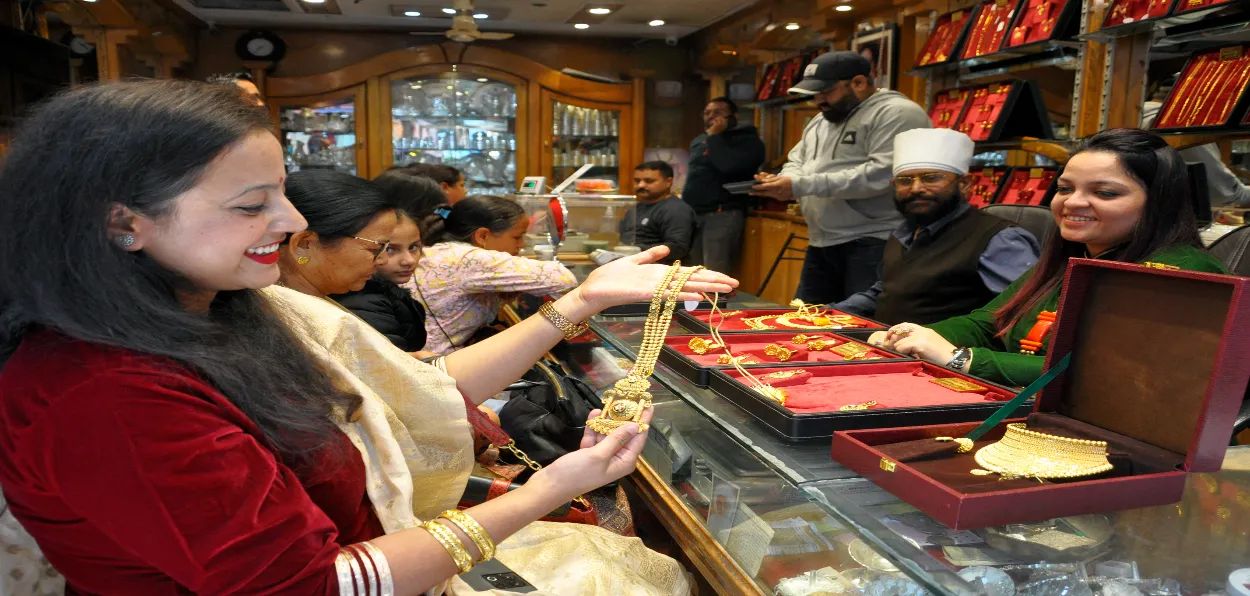
 Sushma Ramachandran
Sushma Ramachandran
The Akshaya Tritiya festival this year has been a dampener for the jewellery industry even though gold prices have shattered records in recent days. Consumers have not shown their usual enthusiasm in buying the yellow metal on this auspicious day, leading to a dip in sales. The reason has been the skyrocketing gold rates, peaking at Rs. one lakh per ten grams in April. Its price fell considerably to around Rs. 95000 during the festival.
The upward price trend prompted jewellers to offer a rush of discounts ranging from cutting making charges and even offering either gold or silver items as bonus gifts. Lightweight gold jewellery was also being offered by most jewellers to suit consumers’ budgets along with a shift to diamond pieces. It is reported that sales in terms of volumes may have fallen by about 30 percent though it may have risen by about 15 to 20 per in value terms.
These developments in the Indian market reflect global developments as international gold prices had also shot up to a record level of 3500 dollars per ounce last month. It has now dipped to around 3300 dollars but the precious metal continues to have a bullish outlook owing to continuing geopolitical tensions. Investment banks like Citi and J.P. Morgan have predicted that prices will remain within 3000 to 4000 dollars by the end of 2025.
The recent spike in gold prices can be traced to the geopolitical tensions of recent years. Gold is considered a “safe haven” asset during uncertainties and turmoil. It was for this reason that prices recorded a spurt during the Covid pandemic. The conflict between Russia and Ukraine was another flashpoint and this was followed by the Israel- Gaza war. The disruption of global supply chains owing to these developments ensured that gold retained its popularity. Then with the advent of Donald Trump as U.S. President, the world faced an unprecedented change in the biggest economy’s trade policies which threatened to lead to trade wars between China, the U.S., and the European Union. This factor is behind the persistent bullish trends in the gold markets.
Bullion rose above the 3000 dollar mark for the first time in mid-March and crossed 3500 dollars at the end of April largely owing to the ongoing tariff battles between the U.S. and China. There were also concerns over Trump’s threat of toppling Federal Reserve chief Jerome Powell along with the prospects of recession in the world’s biggest economy. The weakening dollar was another factor as the yellow metal is denominated in this currency. A declining dollar makes gold cheaper for non-U.S. buyers, thus pushing up demand and prices.
The crisis has now eased with Trump softening his stance while hints of a possible US-China trade deal are in the air. Tariffs on auto components have been exempted; there are prospects of a peace deal in the Russia-Ukraine war. In addition, the dollar is strengthening leading to a decline in gold prices. Yet international prices remain at around 3300 dollars per ounce which is still 25 percent higher than in January.
Gold thus retains its centuries-old fascination for consumers. It may be viewed in the contemporary era as an asset like equity and real estate, but countries like India and China venerate it as a traditional gift in the form of jewelry at weddings and festivals. According to the World Gold Council, jewellery is the largest source of annual demand accounting for 50 percent of total consumption.
Investors like gold because, unlike paper assets like stocks and bonds, gold is tangible and permanent. In addition, it is highly liquid and retains its value during unpredictable times. Central banks also keep gold in reserve to protect national wealth from economic crises. According to estimates, they hold about one-fifth of all gold ever mined. Emerging economies like India and China have been buying more gold to diversify reserves away from the dollar.
India’s gold reserves have risen from 754 tonnes in 2021 to 876 tonnes in 2024. These now account for 11.35 percent of the country’s foreign exchange reserves. India holds the ninth-largest gold reserves in the world.
For retail investors, however, gold has not always been considered the ideal option. It may be glittering at high rates right now and has won many hearts, especially in India but is not a productive investment. Unlike equities, bonds, or real estate, gold does not give dividends, interest, or rent. The profit is only when sold outright.
As for long-term returns compared to other assets like equities, some studies show it is much lower. Since international gold prices were delinked from the dollar only in 1971, a comparative analysis of investments made in gold and U.S. equity markets since then showed that returns have been far higher in the latter. There are varying views on the issue, depending on the period covered for a comparative study. Yet it has the advantage of easy liquidity in times of crisis. Investment experts thus generally advise that gold should form about 15 to 20 percent of an individual’s financial portfolio.
Nowadays it is possible to make investments without having to hold physical gold. Options like gold exchange-traded funds (ETFs), digital gold or government-backed securities like sovereign gold bonds are available. These are all linked to the market price of gold and provide the same benefits as the physical commodity without the hassle of managing and storing the metal.
The latest data available from the World Gold Council shows that the demand for gold ETFs has been rising at a more rapid pace than for jewellery in terms of volumes in the first quarter of 2025. Over the period from January to March, the demand for jewellery has fallen by a huge 25 percent probably owing to the extremely high prices. In contrast, demand for gold ETFs has risen by over seven percent. In terms of value, however, there has been a rise of eight percent in the jewellery segment as against 54 percent for ETFs.
ALSO READ: Kashmir: Sikh villager give his land for pathway to Muslim graveyard
The glitter of gold has thus dimmed somewhat owing to rising prices. However, the advent of new types of gold in digital forms is ensuring that investors can continue to opt for the safe haven asset in a more convenient form. As for the jewellery sector, consumption may have slowed down but is bound to rise again during wedding seasons and festivals. The only difference now is that more buyers will opt to exchange old jewellery for new to reduce costs. The lure of gold will not dissipate as the concept of this precious metal as a security against any crises is part of the Indian psyche.
